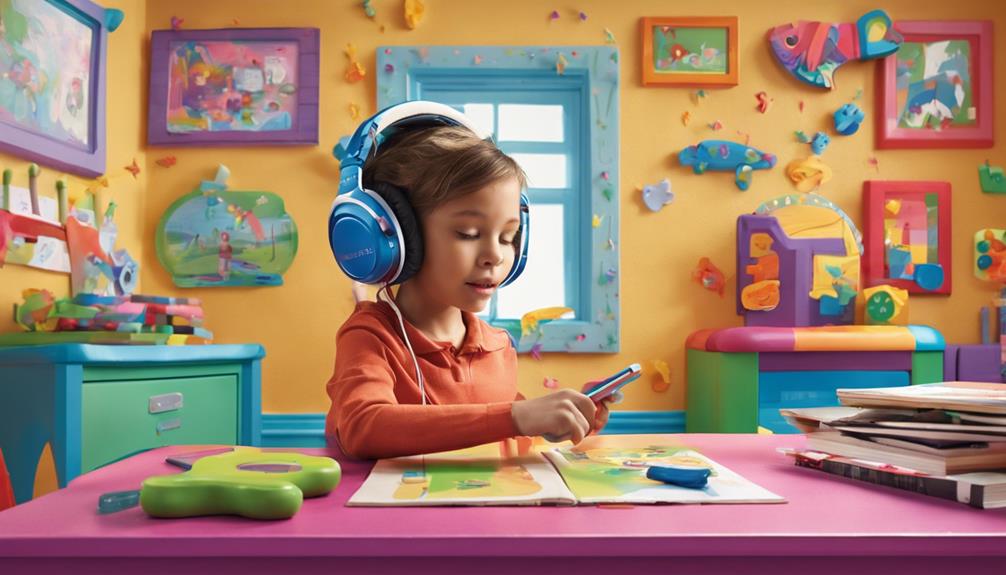When diving into the intricacies of goals focused on auditory processing in speech therapy, it is crucial not to underestimate the significance of these specific goals in fostering strong communication skills.
Delving into strategies that enhance listening comprehension, sound discrimination, and auditory memory, among others, lays a solid foundation for comprehensive speech therapy interventions.
These goals, carefully crafted to address a spectrum of auditory processing challenges, offer a roadmap for therapists and clients alike to navigate the complexities of speech and language development.
Key Takeaways
- Enhance listening comprehension skills to improve overall auditory processing abilities.
- Develop sound discrimination skills for better sound identification and differentiation.
- Improve auditory memory to retain and process information more effectively.
- Strengthen auditory sequencing skills to enhance phonemic awareness and sound blending capabilities.
Enhancing Listening Comprehension
Enhancing listening comprehension in speech therapy involves implementing various strategies to improve understanding of verbal instructions and conversations. One key aspect to focus on is auditory memory, which helps individuals retain and recall information they hear. By targeting auditory memory through exercises like repeating lists of words or sentences, clients can enhance their ability to remember spoken details.
Additionally, working on sequencing skills can assist in organizing information in a logical order, aiding in following conversations effectively.
Setting measurable goals for listening comprehension is crucial in tracking progress and customizing therapy sessions to meet individual needs. These goals should be specific and achievable, such as being able to follow and respond to three-step verbal directions accurately within a certain timeframe. By establishing clear objectives, therapists can evaluate improvement and adjust interventions as necessary.
Improving listening comprehension not only enhances communication skills but also contributes to better academic performance and more successful social interactions. By honing auditory processing abilities, individuals can navigate verbal exchanges with greater ease and confidence, leading to overall improved quality of life.
Developing Sound Discrimination Skills

To build upon the foundation of enhancing listening comprehension in speech therapy, developing sound discrimination skills is a pivotal focus that involves recognizing and distinguishing between different sounds in spoken language. These skills are essential for accurate understanding of speech and language, enabling individuals to differentiate between similar sounds like 'cat' and 'bat.'
Sound discrimination training plays a crucial role in improving auditory processing abilities, particularly in individuals with Auditory Processing Disorder. Speech therapy goals aimed at sound discrimination focus on enhancing the capacity to perceive and differentiate various sounds, contributing to improved language skills and overall communication abilities.
Improving Auditory Memory
Improving auditory memory skills is a fundamental aspect of speech therapy goals, focusing on enhancing the ability to recall and retain auditory information accurately. Working on auditory memory is crucial, especially for individuals with Auditory Processing Disorder, as it can significantly impact their daily functioning and academic performance. Speech therapy interventions targeting auditory memory deficits aim to improve working memory capacity, which is essential for following spoken instructions, remembering numbers, syllables, and sentences effectively.
Speech therapy addresses auditory memory deficits through tailored exercises and strategies. Enhancing auditory memory supports better comprehension, communication, and learning outcomes. Developing working memory skills in therapy can lead to significant improvements in various aspects of an individual's life.
Enhancing Sound Blending Abilities

When addressing the enhancement of sound blending abilities in speech therapy, we focus on:
- Sound blending techniques
- Engaging in practical exercises
- Consistently monitoring progress
By implementing these strategies, we actively work towards improving phonological awareness and overall auditory processing skills in individuals.
These targeted activities aim to strengthen the crucial skill of combining sounds to form words, fostering better reading and communication abilities.
Sound Blending Techniques
Enhancing sound blending abilities through targeted techniques in speech therapy is integral for developing phonological awareness skills essential for reading and language proficiency. Sound blending techniques play a crucial role in improving auditory processing skills and aiding in clear speech production.
Here are three key activities that help enhance sound blending abilities:
- Blending onset and rime
- Blending syllables
- Blending phonemes
Practice With Exercises
Practicing sound blending exercises enhances auditory processing skills by combining individual sounds into words, improving phonological awareness crucial for reading and language development. These exercises are particularly beneficial for individuals with Auditory Processing Disorder (APD) as they help in distinguishing and processing sounds effectively. Sound blending activities typically involve tasks such as blending initial, medial, and final sounds to form complete words. Consistent practice of these exercises can strengthen auditory memory and processing abilities over time.
| Sound Blending Exercise Benefits | ||
|---|---|---|
| Enhances Auditory Processing | Improves Phonological Awareness | Strengthens Auditory Memory |
Monitoring Progress Consistently
To ensure effective advancement in auditory processing goals, it's crucial to consistently monitor progress in sound blending abilities during speech therapy sessions. By tracking the ability to blend sounds accurately, therapists can assess improvements over time using standardized assessments and informal measures.
Documenting changes in sound blending accuracy allows for the adjustment of therapy goals and strategies tailored to each individual's needs. Consistent monitoring not only helps identify areas for improvement but also guides the development of interventions that are most effective for enhancing sound blending skills. This proactive approach in monitoring progress ensures that speech therapy interventions are optimized for achieving auditory processing goals.
- Monitor progress by tracking sound blending accuracy.
- Use standardized assessments and informal measures for evaluation.
- Document changes to adjust therapy goals and strategies.
Strengthening Auditory Sequencing Skills

Developing strong auditory sequencing skills is crucial for improving overall listening comprehension and communication abilities. These skills involve the ability to order and recall sounds in the correct sequence, which is essential for processing instructions, following conversations, and learning language effectively. By targeting auditory sequencing in speech therapy, we can support not only auditory processing but also language development.
To enhance auditory sequencing proficiency, activities like repeating sequences of sounds, words, or sentences can be beneficial. Below is a table outlining some specific strategies that speech therapists may use to strengthen these skills:
| Auditory Sequencing Strategies | Description | Benefits |
|---|---|---|
| Repeat Backwards Sequences | Recalling sequences in reverse order | Improves memory and sequencing abilities |
| Sequence Repetition with Visual Aids | Pairing auditory sequences with visual cues | Enhances comprehension and retention |
| Story Sequencing Activities | Organizing story events in correct order | Develops narrative skills and sequencing proficiency |
| Musical Patterns and Rhythms | Replicating musical sequences | Enhances auditory discrimination and sequencing skills |
Implementing these strategies can significantly impact a client's auditory processing and language development positively.
Building Phonemic Awareness

When building phonemic awareness, we focus on developing sound discrimination skills and the ability to segment speech sounds. These skills are crucial for understanding the individual sounds within words, which is essential for reading and language development.
Sound Discrimination Skills
Sound discrimination skills play a crucial role in speech therapy by enhancing phonemic awareness. This involves identifying and manipulating individual sounds in words. Developing these skills aids in recognizing subtle differences in sounds and is fundamental for reading and spelling success.
Sound discrimination activities often include tasks like identifying initial, medial, and final sounds in words. These activities not only improve auditory processing but also help individuals become more proficient in distinguishing between similar sounds, which is vital for accurate speech production.
Segmenting Speech Sounds
How can segmenting speech sounds contribute to enhancing phonemic awareness for individuals with auditory processing goals in speech therapy sessions?
Segmenting speech sounds plays a crucial role in developing phonemic awareness, a key skill for individuals with auditory processing goals. By breaking down spoken words into individual phonemes, this practice helps individuals with Auditory Processing Disorder (APD) differentiate and manipulate sounds, aiding in the success of their speech therapy.
Phonemic awareness is essential for reading and spelling skills development, making segmenting speech sounds a foundational skill for effective communication. Building phonemic awareness through segmenting speech sounds can significantly enhance auditory processing abilities in speech therapy sessions, ultimately promoting better outcomes for individuals with auditory processing goals.
Enhancing Sound Localization

Enhancing sound localization in individuals with auditory processing challenges involves accurately identifying the direction of a sound source in space to improve spatial auditory processing. This skill is essential for daily activities, safety, communication, and spatial awareness.
To enhance sound localization effectively, consider the following:
- Engage in Sound Localization Games: Fun activities can help individuals practice identifying where sounds are coming from, improving their ability to locate sound sources accurately.
- Practice Sound Localization Exercises: Specific exercises designed to challenge the individual's ability to pinpoint the direction of sounds can enhance spatial auditory processing skills.
- Differentiate Between Sound Sources: Therapy techniques focusing on distinguishing between sounds from various locations can aid in improving sound localization abilities, leading to better auditory information processing and social interactions.
Improving Speech-in-Noise Perception

Improving speech-in-noise perception is crucial for individuals with auditory processing disorder (APD) as it significantly impacts their daily communication and academic performance. Speech-in-noise perception poses a common challenge for those with APD, leading to difficulties in understanding speech in noisy environments.
To address this issue, various strategies can be employed. Preferential seating, FM systems, and noise-canceling headphones are effective tools to enhance speech-in-noise perception. Collaborative efforts between audiologists and speech-language pathologists play a vital role in assessing and tackling speech-in-noise perception issues.
Developing Auditory Processing Speed

When addressing the goal of developing auditory processing speed in speech therapy, our focus lies on improving the rate at which individuals comprehend and respond to auditory information.
By enhancing listening efficiency and processing accuracy, we aim to boost the speed of sound perception for better communication outcomes.
Strategies like auditory discrimination tasks and timed listening exercises are utilized to target these specific areas of auditory processing.
Speed of Sound
To enhance auditory processing speed, engaging in auditory discrimination activities, sound recognition exercises, and processing speed drills can be highly beneficial.
- Auditory Discrimination Activities: These activities focus on distinguishing between similar sounds to improve the brain's ability to process auditory information quickly.
- Sound Recognition Exercises: These exercises involve identifying and categorizing various sounds, which can help in recognizing and interpreting speech sounds more efficiently.
- Processing Speed Drills: These drills aim to enhance the brain's speed in processing auditory information, leading to improved listening comprehension and faster response times in conversations and educational settings.
Listening Efficiency
Enhancing listening efficiency through the development of auditory processing speed is crucial for optimizing communication skills in speech therapy sessions. Quick auditory processing speed enables individuals to process auditory information effectively, improving comprehension. In therapy, goals often include enhancing reaction times to auditory stimuli and the ability to rapidly process spoken information.
Efficient auditory processing speed is vital for following conversations, instructions, and verbal cues across different settings. By improving auditory processing speed, individuals can enhance their overall auditory perception, leading to better communication skills. Strengthening auditory processing speed can significantly impact an individual's ability to engage in conversations, follow directions, and participate actively in various communication activities during speech therapy sessions.
Processing Accuracy
Developing auditory processing speed in speech therapy involves honing the ability to accurately recognize and interpret auditory information at a rapid pace. Individuals with Auditory Processing Disorder may benefit greatly from interventions aiming to enhance processing accuracy.
When targeting processing accuracy in speech therapy, the following key points should be considered:
- Implementing exercises to improve speed and accuracy in auditory processing.
- Utilizing techniques such as auditory discrimination tasks to enhance processing skills.
- Monitoring progress in processing accuracy through regular assessments and feedback.
Fostering Multisensory Integration

In our approach to fostering multisensory integration in speech therapy, we emphasize the seamless blending of auditory, visual, and tactile stimuli to optimize learning and communication outcomes. By incorporating multiple sensory modalities, we aim to enhance neural connections and improve auditory processing goals for our clients. Through the use of visual aids, gestures, and tactile feedback alongside auditory input, we create a rich learning environment that supports better processing of speech sounds. Research indicates that multisensory interventions are particularly beneficial for individuals, especially children, with auditory processing difficulties, as they engage various senses to enhance comprehension and retention.
| Benefits of Multisensory Integration |
|---|
| Enhances neural connections |
| Improves speech and language outcomes |
| Supports comprehension and retention |
| Engages multiple senses |
| Creates a rich learning environment |
Frequently Asked Questions
How to Treat Auditory Processing Disorder in Speech Therapy?
In speech therapy, we treat auditory processing disorder by implementing compensatory strategies to improve memory and processing skills. Our focus is on enhancing phonological awareness, articulation, and language abilities affected by the disorder.
Collaborating with parents, teachers, and professionals is vital for successful therapy. Our goals include teaching chunking techniques to boost information retention and enhance overall communication skills.
We strive to reduce the impact of auditory processing disorder on speech and language development.
What Are the Goals for Auditory Discrimination in Speech Therapy?
In speech therapy, our goals for auditory discrimination involve improving the ability to distinguish between similar sounds. By enhancing auditory processing skills, we help individuals better recognize speech sounds, leading to clearer communication.
Addressing difficulties in discerning sound patterns can enhance listening skills and understanding of speech. Ultimately, developing auditory discrimination skills can result in improved comprehension, speech clarity, and overall success in therapy sessions.
What Are the IEP Goals for Auditory Comprehension?
We set IEP goals for auditory comprehension to enhance understanding and processing of spoken language. These objectives focus on improving the capacity to interpret and respond accurately to auditory information.
Our targets include boosting listening skills, comprehension of verbal cues, and effectively following multi-step directions. By increasing the length and complexity of instructions understood, we aim to enhance auditory memory for retaining and recalling information heard.
What Is the Role of a Speech Pathologist in Auditory Processing?
In our work, we focus on assessing and treating auditory processing disorders (APD).
We evaluate auditory skills, language abilities, and cognitive functions related to sound processing. Collaborating with audiologists and other professionals, we develop personalized therapy strategies for APD.
Our interventions aim to improve auditory memory, phonological awareness, and speech skills affected by APD. We help clients learn compensatory strategies to enhance communication and learning outcomes.
Conclusion
In conclusion, by focusing on auditory processing goals in speech therapy, we can enhance listening comprehension, develop sound discrimination skills, improve memory, and strengthen speech-in-noise perception.
Through collaboration with parents and professionals, setting goals for chunking information, and implementing visualization techniques, we can foster multisensory integration and enhance overall communication abilities.
By addressing these key areas, individuals can improve their auditory processing skills and ultimately enhance their ability to effectively communicate and engage in conversations.











